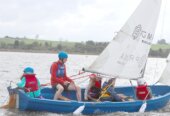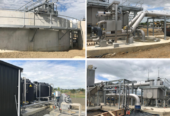King Country landscapes by three of New Zealand’s most revered artists are part of the Timeline: Waikato Art 1850 to 2000 in the reopened Te Whare Taonga o Waikato Museum and Gallery.

King Country Landscape. John Weeks – Te Whare Taonga o Waikato
Paintings by Peter McIntyre and John Weeks are on display in the exhibition, which opened last week.
Weeks who was born in England in 1886 and emigrated to a farm at Mangapiko near Te Awamutu in 1892, was an influential figure for many of New Zealand and Waikato’s regionalist paintings.
His King Country landscape shows many of the characteristics of Week’s painting style and use of colour. In 1958 he was awarded the OBE for services to art and died in 1965.
McIntyre’s oil landscape from 1975 has a surreal element in the style often used by the World War II official artist in his later years when he had a holiday home in Kakahi, south of Taumarunui.
Born in Dunedin in 1910, McIntyre was a prolific artist who was also awarded an OBE for services to art. He died in 1995.

The King Country 1975 Peter McIntyre – Te Whare Taonga o Waikato
The other with King Country connections is Taharoa Farm 1950 by Violet Watson, who was born in 1906. The rural landscape oil painting by the artist was a particular favourite of Watson’s who died in Hamilton in 1992.
A painting of Hautapu School featuring a school building nestled behind thick bush in 1987 is part of the exhibition.
Dunedin-born Rodney Hamel, 87, who specialises in landscapes and portraits, was a teacher of history and geography at St Paul’s Collegiate in Hamilton from 1963-2000 and often painted the Waikato landscape from the top of Maungakawa.
The Hautapu School painting is part of an extensive Waikato collection.
He used water colours until the 1990s when he began learning to pain with oils and returned to live in Dunedin in 2004.

Hautapu School, 1987, by Rodney Hamel. Photo: Te Whare Taonga o Waikato Museum and Gallery
The exhibition also features an image of Arapuni Dam by photographer Laurence Aberhart and early watercolours of the Waitomo Caves, Pirongia from Mangatama and the Waipā River at Ōtorohanga.
After a six-month closure for extensive renovations, the museum is ready to welcome visitors to their opening weekend’s ‘housewarming’ celebration to experience the improvements as well as the four new exhibitions alongside established favourites including Exscite.
Other highlights include the traditional and contemporary handcrafted weaving works in He Aa I Uta, He Aa I Tai: Weaving the Elements, details from the museum’s own history in Exhibition no. 831 and the prestigious international Astronomy Photographer of the Year exhibition, showcasing award-winning images of the universe.
The primary focus of the renovation was to bring the building up to modern museum standards, including crucial roof repairs and the installation of a new air lock entry for enhanced climate control.
The museum has opened after a six-month closure for renovations.

Taharoa Farm 1950 Violet Watson – Te Whare Taonga o Waikato








